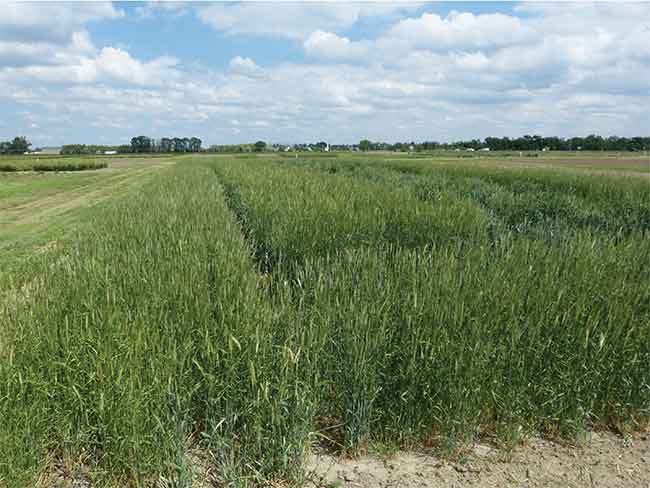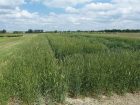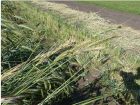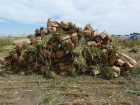
Features
Agronomy
Diseases
Developing ergot-resistant cereals
Over the past 15 years, ergot has shifted from being a sporadic, localized problem to a widespread disease issue for Prairie cereal growers. As a result, ergot research has become a rising priority for researchers and producer-driven research funding agencies. A key part of the current research focuses on developing crop varieties that are less susceptible to ergot.
October 3, 2016 By Carolyn King
 Larsen and Turkington have set up ergot nurseries at Lethbridge and Lacombe for screening of Larsen’s fall rye lines for ergot susceptibility. Over the past 15 years
Larsen and Turkington have set up ergot nurseries at Lethbridge and Lacombe for screening of Larsen’s fall rye lines for ergot susceptibility. Over the past 15 yearsMany cereal crops and grassy weed species are hosts to Claviceps purpurea, the fungus that causes ergot. The pathogen overwinters as sclerotia, hardened black or dark purple fungal bodies. In the spring under moist conditions, the sclerotia germinate, forming little mushroom-like bodies that release ascospores (sexual spores) into the air. The ascospores enter open florets of flowering host plants, land on the stigmas and infect the ovaries. There the pathogen produces sugary honeydew that contains asexual spores called conidia. Rain splash and insects attracted to the sticky honeydew spread the conidia to other florets. The sclerotia develop in the infected florets, and then fall to the ground or are harvested with the crop.
“The ergot sclerotia replace the kernel in the floret, which will result in yield loss. But that yield loss is usually very small, not something that the farmer would normally be worried about,” explains Jim Menzies, a plant pathologist with Agriculture and Agri-Food Canada (AAFC) in Morden, Man.
The big concern with ergot is that the sclerotia contain various toxic alkaloids. He says, “The ergot sclerotia are often harvested with the grain. And because of those toxic alkaloids, if there is too much ergot in the grain, there will be a downgrading of the grain or in some cases a rejection of the grain for sale at the elevator.” Consumption of ergot-infested grain can cause very serious health problems in humans and other animals, including cattle.
A plant’s window for ergot infection depends on how long its florets remain open and unfertilized. Some crops, like rye, are open-flowering, cross-pollinated species, so their florets stay open longer to allow their stigmas to catch wind-borne pollen. Therefore they have a longer window for ergot infection compared to self-pollinated crops like wheat. Menzies says, “Rye is the most susceptible crop, and generally triticale is considered to be next, followed by wheat, then barley, then oats.”
Another factor is how fast pollination occurs. “The literature has shown that once a pollen tube pollinates an embryo, within five to seven days that embryo is completely resistant to ergot infection,” Menzies notes. “So the more rapid pollination, the smaller the chance for the pathogen to infect.” Additional factors include cool, wet weather, which tends to lengthen the flowering period, and a copper deficiency in wheat or a boron deficiency in barley, which leads to pollen sterility and causes the flowers to open up.
No fungicides are registered for ergot control on the Prairies. Although some commercial cereal varieties have moderate ergot resistance, none are resistant. “Farmers need an integrated control package with things like using a proper crop rotation, mowing ditches and headlands to make sure the disease doesn’t spread from other grasses, making sure your fertilization regime is correct, and removing the ergot from infested grain [using colour sorters and/or gravity tables],” Menzies stresses. Other tips include using clean seed, and seeding at a higher rate and a consistent depth for a more uniform crop stand.
Why the rise in ergot?
“In the last half of the 20th century, ergot occurred probably every 10 to 15 years and only in small pockets of the Prairies. And it would be there for a year or two, and then it would be gone. So it was very hard to get a good grasp on what was happening,” Menzies says. “It’s only since about 2000 that ergot started to become much more general across the Prairies and much more common.”
“We’ve been looking at data produced by the Harvest Sample Program on samples downgraded due to ergot to obtain information on the incidence and intensity of ergot,” says Sheryl Tittlemier, a research scientist with the Canadian Grain Commission. Analysis of the data shows ergot levels vary from year to year, but overall ergot levels have increased. “From 2002 to 2013, the number of CWRS [Canada Western Red Spring] and CWAD [Canada Western Amber Durum] samples downgraded due to ergot and the per cent ergot in the samples increased, suggesting the occurrence and severity of ergot have increased.”
Several factors may have contributed to ergot’s increase. “One reason could be farmers moving more toward zero till. When they used to plough after the crop, they would bury the sclerotia so the sclerotia would no longer be available to produce spores in the spring. But with zero till, the sclerotia sit on the soil surface, which is ideal for this pathogen,” Menzies says. Tittlemier notes, “From 2002 to 2008, the percentage of land under zero tillage in the Prairie provinces increased from about 35 to 55 per cent.”
According to Menzies, shortened crop rotations have probably also played a role. “For numerous diseases on numerous hosts, a crop rotation should be a minimum of three years, and probably four years is better, to help reduce the amount of inoculum.…The literature suggests ergot sclerotia survive for about one year. However, I think a certain percentage of them probably survive a little longer, perhaps two or three years.”
Tittlemier identifies other possible factors such as an increase in the use of grassy field margins, and changes in environmental conditions like weather patterns or soil conditions that favour the disease.
There’s no way to know if more virulent ergot strains might have contributed to the higher ergot levels. Menzies says, “We know there are different strains, but we can’t say if the strains are changing or if certain areas have more virulent strains than other areas, simply because there hasn’t been enough work done [on that aspect] to determine that.”
A priority for fall rye
High ergot levels prompted Jamie Larsen to include ergot resistance as a priority in his breeding program for open-pollinated fall rye. “We grow the fall rye co-operative registration trial across many sites in Western Canada. At some of the sites, the amount of ergot in the samples would be two, three, four, eight per cent for some of the lines in the trial,” Larsen, a cereal breeder with AAFC in Lethbridge, Alta., says. (For No. 1 grade rye, per cent ergot is 0.05 or less.)
Larsen set his fall rye breeding objectives in collaboration with the Saskatchewan Winter Cereals Development Commission, the producer group that funds his program. Along with lower ergot levels, his program’s objectives include higher falling numbers (a measure of bread-making quality), higher yields and shorter straw (for reduced lodging, easier harvesting and easier residue management).
Fall rye varieties with less ergot would reduce seed cleaning costs for producers who grow the crop for grain and would enhance the use of fall rye for grazing and silage.
Although genetic differences in resistance may be involved in the differing responses of fall rye lines to ergot, Larsen suspects a major factor is probably the timing and amount of pollen shed. “If there isn’t enough pollen around, then you won’t get fertilization of the florets, which leaves them open for ergot infection,” he notes. For example, if cool, wet weather extends the tillering or flowering period, then the crop may produce a large pulse of pollen followed by lower amounts of pollen, making it difficult to get complete fertilization of the later spikes.
Larsen and Kelly Turkington, a plant pathologist with AAFC in Lacombe, Alta., have set up ergot nurseries at Lethbridge and Lacombe to screen Larsen’s lines for susceptibility. In the two nurseries, they apply about 80 to 90 kilograms per hectare of ergot sclerotia to provide high levels of inoculum. In addition, at the Lethbridge nursery, they are using irrigation to try to create moist conditions that favour ergot – an uphill battle in the face of the region’s extremely dry weather in 2015 and 2016.
“The ergot nurseries are an incredible amount of work,” says Larsen. “We plant the lines and then take them off at the soft dough stage. We bag the heads, put them in a dryer for a couple of weeks, and then thresh each bundle individually. Then we put it through our colour sorter to remove the sclerotia. Then if there is still some sclerotia in the sample, my team has to use tweezers to pick them out.
“…Some of the material that we’re screening has quite large variations in heading and anthesis [flowering] dates. So we have a border around the outside [of the nursery] that releases pollen. Otherwise, there wouldn’t be much pollen available for the lines that are the first to flower and the lines that are the last to flower, so they wouldn’t get pollinated and would appear to be horribly susceptible to ergot, but in fact it’s just bias based on anthesis date.”
So far, Larsen has several generations of crosses, and he is hopeful that he’ll be able to release varieties with lower ergot levels in the coming years. The next step in his fall rye breeding program is to add two more breeding objectives: Fusarium head blight (FHB) resistance and leaf rust resistance.
Larsen’s next step in his ergot research in fall rye is to evaluate management options. He and Turkington are hoping to compare different seeding dates, seeding rates and nitrogen rates to assess the effects on the amount of tillering, the length of the flowering period and the levels of ergot.
As well, in Larsen’s triticale breeding program, he and Turkington are using the two ergot nurseries to screen triticale lines.
Barrier method for spring wheat
A three-year project, which started in 2015, could help reduce ergot in spring wheat varieties. The idea is to create “fully cleistogamous” wheat lines. “ ‘Cleistogamous’ means closed flowering, so the anthers don’t protrude from the floret at the flowering stage. So you don’t see the yellow anthers hanging from the spike that you normally see around flowering time. ‘Fully cleistogamous’ means the anthers always remain enclosed in the floret,” explains Patricia Vrinten, a researcher with the National Research Council of Canada who is leading the project.
Her project’s main goal is to develop fully cleistogamous wheat lines to improve resistance to FHB. In FHB, the anthers are thought to be an infection site for the pathogen, so genotypes where the anthers are always enclosed could reduce FHB levels.
Since wheat florets usually open for a short time, wheat lines with permanently closed florets could have better ergot resistance because the spores can’t get into the florets to land on the stigma. She says, “Cleistogamy essentially acts as a barrier to the ascospores during the time that infection could occur.”
Because full cleistogamy is unusual in wheat, Vrinten is looking for the trait in germplasm that has a lot of genetic diversity. “I’m working with a collection of landraces from around the world. These are lines that were traditionally grown by farmers in various areas, as opposed to
registered cultivars,” she says. “There is a great deal more variation in landraces than amongst the cultivated varieties for many traits, including cleistogamy.”
She notes, “Since we are working with landraces, we expect that some of the other characteristics of these lines, such as yield and quality, won’t be very good. So once we’ve identified the trait, we plan to develop [DNA] markers that will allow us to easily introduce the trait into adapted varieties so we can combine the cleistogamous trait with other beneficial and adapted traits.”
This project is funded by the Saskatchewan Wheat and Development Commission and Western Grains Research Foundation (WGRF), and by Saskatchewan’s Agriculture Development Fund.
Challenges in bread wheat
To improve any trait in any crop, there’s always the challenge of putting that one trait into a package with other important characteristics to create a top-notch commercial variety. Santosh Kumar, a wheat breeder at AAFC in Brandon, Man., explains meeting this challenge can be especially tough in bread wheat breeding because of the many traits that have to be pooled together in each variety, such as strong yields, good resistance to various diseases, and stringent quality specifications, including the recently tightened requirements for gluten strength in this wheat class.
“I breed Canada Western Hard Red Spring wheat for the eastern Prairies of Canada,” Kumar says. “My focus is to incorporate the semi-dwarf trait in our bread wheat germplasm suited to the eastern Prairies, and then improve the yield, protein, sprouting resistance, FHB resistance, bunt resistance and stripe rust resistance in the semi-dwarf type. We already have a good handle on leaf rust and stem rust resistance, but we are trying to get resistance to Ug99 stem rust [a virulent type of stem rust], which is currently not a problem in Canada but may be in the future.”
Kumar’s program is funded primarily by AAFC and WGRF, with additional funds from SeCan and provincial grower organizations like the Manitoba Wheat and Barley Growers Association.
Though ergot resistance is not a priority for the program, that doesn’t mean ergot is being ignored. Kumar’s predecessor, Stephen Fox, did some work with Menzies on ergot resistance. “Kenya Farmer, a source of resistance in bread wheat, was introduced into the breeding program and crosses were made,” says Kumar. “Some disease-resistant lines came out of that, but unfortunately due to the precedence of other traits over ergot resistance, the lines with ergot resistance could not move forward as a variety.”
The increased importance of ergot on the Prairies has sparked and intensified efforts to develop better tools to manage ergot, including resistant varieties. For now, Menzies says, “Producers have to keep this pathogen in mind, and they need to use an integrated approach to manage it.”



